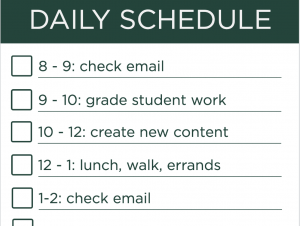The novel coronavirus (COVID-19), has caused many PreK-12 schools to transition from face-to-face instruction to some form of online learning. In order to support the transition to remote learning, the faculty, students, and alumni of the Master of Arts in Educational Technology (MAET) program have put together several blog posts which will focus on general considerations, challenges, and specific strategies at the PreK-12 level.
In this first post of our series, we would like to start with an essential topic: teacher well-being during the transition to a new and different routine, under the pressure of the current circumstances. The world is not the same as it was a month ago, a week ago, even yesterday. We are not public health officials, but we do spend our professional lives steeped in the world of online and distance teaching and learning. Although there are no magic solutions, we have some ideas on how to help make the transition from your “normal” school day routine to your “new” professional routine to try to help you maintain a work-life balance and personal well-being.
Don’t work more than you normally do. When things change and you have to adjust your work, things will naturally take longer. We recommend setting timers and saying “I’m going to do this task for 1 hour” and then really focusing for that hour. The Pomodoro Technique is an easy strategy to implement, which some of our colleagues use to focus on specific tasks for the sake of productivity. Also consider advice from Elena Heglund, who offers some practical wisdom for prioritizing.
Figure out a routine. It’s probably best to keep similar “hours” to your “regular” teaching day, but that might not be a reality for you. Consider this potential start to your day:

As you build your new routine, consider these questions:
- When will you check email? Aim for 1 or 2 specific times a day. Read about Richard Eaton’s experience with moving to checking email only twice a day.
- When will you grade student work? Again, we recommend chunks of designated times.
- When will you create new content? (If you are maintaining and creating digital content as a part of your instructional plan)
- What time is most quiet at home if you’re recording videos?
- What days/time will you connect with your colleagues for co-planning?
- What times will you host live (synchronous) video chats as a part of content delivery?
- When will you eat and take breaks? We know breaks are necessary for creative thought and mental health. Devote time to maintain your self-compassion.
As you are likely to have others in your home, this schedule may be challenging to keep, but should help give you some sense of balance and normalcy.
Share your schedule with your students (and parents!). When MAET Graduate Certificate Director Brittany Dillman teaches online (under “normal” circumstances) she is very clear: “I will be able to get back to you within 1-2 hours from 9a-4p Eastern time on M-F. I will check email once in the evening and once per day on weekends and reply to things that are urgent.” Transparency in your email practices will help you turn things off each day, lessening your urgency to be connected 24hrs/7 days a week. Information overload can heighten anxiety. To learn more about how to reduce screen time and the impact of it, please visit this article by Nina Schroder.
Limit checking the news and social media. Life is really uncertain. Be informed, but try not to be glued to the news. Here are 3 reputable sources:
Get outside and move your body. If you no longer have a daily commute, be intentional about how you reallocate that time. Can you get out for a 15 minute walk in the morning and afternoon? A 30-minute bike ride at lunch time? Go to the park with your family after your children take their afternoon nap? Tools like Firefox add-on Water Walk or Google Chrome Extension Stand Up! Timer can help to remind you to step away from your device, take a break, and move around.
Find support. Reach out to your colleagues and friends for help and to see how they are doing. Checking in with your professional learning network (PLN) can lead to shared practices and strategies, and also provides connection and normalcy. For example, here are some resources that we’ve found helpful for K-12 educators from our PLN:
- ‘Students Are Lonely:’ What Happens When Coronavirus Forces Schools Online by Stephen Noonoo
- School Closure Planning Document by MAET instructor, Nicole Zumpano
- Online learning, teaching and education continuity planning for schools via International Baccalaureate
- Online Learning: A Strategic Approach for K-12 Schools via International Schools Services
You may also find some support in maintaining your well-being through guided meditation or humorous videos on YouTube or your favorite apps like Calm and Headspace. Whether you relax most when you exercise, are practicing mindfulness, or cooking—whatever the method may be—make sure that you support yourself in finding the time to make those things a part of your new routine. And, as you do this, remember that you are not alone on this journey.
The MAET community is here to support you. Looking for a resource? Feeling stuck with your next step? Trying to troubleshoot something? In search of inspiration? Have something funny or inspirational to share? Send a tweet to #MAET to connect.




